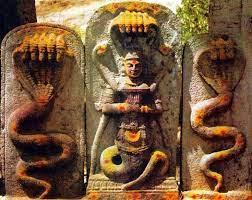The Story Behind Nag Panchami

Since ancient times, people have
worshipped nature, having recognized its role and importance in their life.
Natural forces and entities like the Sun, Moon, trees, animals, rivers, oceans,
and mountains were deeply connected to human existence and survival. The ancient
Egyptians worshipped cats, dogs, crocodiles, scarab beetles, etc., while the
Chinese worshipped lions and turtles. In India, Hindus worship snakes and cows
even now.
Nag Panchami is
an important Hindu festival that honors Nag Devtas or snake gods.
It falls on the 5th day of Shukla Paksha
in the month of Shravan (July-August). It is a major festival in many parts of
the country, like South India, West Bengal, and Maharashtra. It is believed
that snakes saved the human race from the wrath of demons and that the earth is
balanced on the head of the serpent called Sheshnag, on whom Vishnu reclines.
There are many interesting legends about the festival.
History
of Nag Panchami
Long before the arrival of the Aryan
race in India, the Naga clan lived in India. It was a very evolved clan, and
the people worshipped snakes. Eventually, the Naga culture merged with
Hinduism, and the Indo-Aryans also began to worship the snake gods. The major
Nagas or snakes mentioned in the Puranas are Ananta, Vasuki, Shesh, Padma,
Kanwal, Karkotak, Kalia, Aswatar, Takshak, Sankhpal, Dhritarashtra and Pingal.
But some historians say that they were Naga kings of various kingdoms and not
snakes. But people revered them as gods.
Hindus believe that the 1000-headed
Sheshnag, who represents Eternity, holds the entire earth on its head. In
Jainism and Buddhism, too, serpents are holy creatures. Some ancient texts
claim that a cobra saved the life of Buddha and the Jain Muni, Parshwanath.
Ancient architecture testifies to the
significance of snakes in Indian culture as well. There are images depicting
the rituals of snake worship in the Ajanta caves. Indian literature has many
stories about snakes. Kautilya, in his “Arthashastra,” has described cobras in
great detail. People believe that worshipping snakes can protect them from
snakebites.
Nag Panchami vrat/fast finds mention in
the Puranas. It is one of the most auspicious days of the year. As per the
Bhavishya Purana, men bathe the snakes Vasuki, Takshaka, Kaliya, Manibhadra,
Airavata, Dhritarashtra, Karkotaka, and Dhananjaya with milk on this day to
ensure protection from snakes for their families. People do not plow fields on
this day to avoid harming snakes.
Stories
about Nag Panchami
There are many stories related to Nag
Panchami.
A popular legend says that Balram, the
elder brother of Krishna, was the incarnation of Sheshnag on earth. Snakes also
adorn Shiva’s neck. The fact that Nag Panchami occurs in the month of Shravan
(the sacred month of Shiva) also reinforces Shiva’s connection with snakes.
Nag Panchami is also said to commemorate
the encounter between Krishna and the dreaded serpent, Kaliya, which was
terrorizing the villagers of Gokul. Krishna subdued it and danced on its head,
after which the snake left Gokul forever.
Another legend talks about King
Janamejaya’s Sarpa Satra, a powerful Yagna to kill the entire race of snakes,
as the king of snakes, Takshaka, had killed Janamejaya’s father, King
Parikshit. However, before the entire snake clan perished, Sage Astika
intervened and persuaded the king to stop the Yagna.
Another story claims that one day while
tilling his land, a farmer killed some young serpents by mistake. The serpents’
mother killed the farmer and his family in revenge. The farmer’s daughter, who
was praying to the Nagas, however, escaped. Her prayers helped restore the
lives of her family members. Since then, people have been celebrating the
festival in India.
Nag
Panchami Customs
Devotees flock to temples that have
shrines for the snake gods and offer milk and turmeric powder to the snake
deities. In some places, live cobras are given a ritual bath in milk and fed
rice. Women also participate in the celebrations. They arise early in the
morning, take a bath and visit the nearest Snake temple with pots of milk and
flowers as offerings. If a snake drinks milk, it is believed to bring good
fortune.
In many parts of Bengal, people worship
Manasa Devi, the Queen of Snakes. The snake Goddess is worshiped for protection
from snakebites. Devotees offer raw milk and five plantains to the Goddess.
Mostly, it is women who worship Goddess Manasa. This tradition still exists in
some parts of Bengal. Another tradition is the smearing of red sandalwood paste
on clay images of snakes and wooden boards. The images are usually in yellow or
black color.
In Punjab, a large dough snake is
created and paraded around the villages. The parade is accompanied by singing
and dancing. People bury the dough snake at the end of the parade to mark the
end of the ritual. In Maharashtra, women offer milk, flowers, turmeric powder,
and kumkum to the snakes that are carried by snake charmers. The snake charmers
carry pots that contain the cobras to a central temple and free them, after
which people worship them.
Other festivals in India that honor
snakes are Naga Chaturthi and Nagula Chavithi.
Nag Panchami is on August 21 in 2023.
Post Your Ad Here
Comments